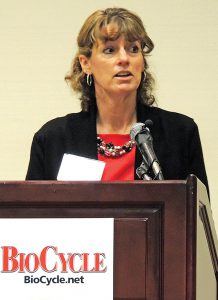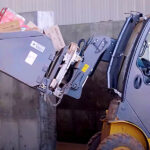In a question-and-answer session, Caroll Mortensen, Director of the California Department of Resources Recycling and Recovery (CalRecycle), highlights accomplishments and discusses next steps to advance organics management.
BioCycle March/April 2014

Caroll Mortensen, Director, California Department of Resources Recycling and Reocvery (CalRecycle)
BioCycle: BioCycle frequently makes the statement that if the nation adopted the climate protection policies that California has, our country would be much further along in its transition to renewable sources of fuel and power, as well as organics diversion. Can you tell us how CalRecycle is working to help reduce GHG emissions from an organics management standpoint?
Mortensen: Well, we certainly agree with you on that point! And there’s no doubt organics management will play an important role in California’s efforts to reduce greenhouse gas emissions and adapt to a changing climate. The California Air Resources Board’s AB 32 Scoping Plan notes that the primary source of GHG emissions from waste management in California is the direct emission of methane from organics decomposing in landfills. The bottom line? Diverting organics from landfills reduces the amount of methane generated from that source. And when we make good on the inherent value of those organics by composting them, or turning them into clean energy, we multiply the impacts, because we’re revitalizing our farmland, reducing water needed for irrigation, and creating new fuels that displace electricity made from fossil fuels and replace diesel fuel in trucks.
We’ve already made a lot of progress. California’s annual waste sector emissions have dropped dramatically — by at least 3 million tons of CO2 equivalent, and emissions continue to decline. And thanks in part to more and more folks understanding the value of organics as a feedstock for clean energy, and what organics emit in landfills, we’re on the verge of making tremendous advances. There is a lot of excitement about anaerobic digestion (AD) right now, and the electricity or fuels we make from AD could go a long way toward making the waste sector carbon neutral.
Highly important to our work are the partnerships we have with all the public agencies and private stakeholders, from the Air Resources Board (ARB) and the California Energy Commission to state universities, sanitation districts and private businesses. This is how we accelerate progress — and it’s what allows us to be more aspirational. Our collective focus recently has been the Waste Management Sector element in the AB 32 Scoping Plan Update.
In particular, because our success demands the existence of stable markets for products generated by composting and AD, we’ll continue to work with the private sector to develop those end uses. For instance, thanks to our collaboration with ARB and our work with the Legislature and Governor’s Office, we have an opportunity in 2014 to implement the first-ever California grant and loan program dedicated to expanding and renovating California’s organics infrastructure.
BioCycle: This is exciting news! Can you elaborate on the new grant and loan program?
Mortensen: The Governor’s proposed budget includes $30 million in GHG reduction funds to distribute through a competitive program with a focus on new and expanded California composting and AD facilities. We held a workshop in early February to show stakeholders our draft proposals for how the grants and loans will work. There was a lot of interest. We laid out the goals and objectives of the program and the proposed scoring criteria. All this information is available on our website (www.calrecycle.ca.gov/Climate/GrantsLoans/). I encourage your readers and all our colleagues to check it out. We’re hoping to launch the process this spring with applications due over the summer, and awards made in the fall.
We’re looking for proposals that will reduce greenhouse gases, while enabling communities to meet their economic and environmental goals through better organics management. This is a sound basis upon which to grow our organics processing infrastructure, and we’ll continue to pursue additional opportunities using GHG Reduction Fund dollars.
BioCycle: Considering that California has a statewide goal of 75 percent recycling, composting or source reduction of solid waste by 2020, how do you see California’s current organics processing infrastructure growing to meet this challenge?
Mortensen: Right now, about 10 million tons of organics are recycled for compost, mulch, biofuels and bioenergy here in California. And of course, this is a success story itself as it represents tremendous — and in the eyes of some, improbable — progress over the past 20 years.
We have about 140 composting facilities processing somewhere around 5.5 million tons of feedstocks annually. We have over 100 chip and grind facilities processing additional organic material that goes to a variety of uses, including composting, mulch, and to biomass conversion facilities that produce renewable energy.
But the fact is, this only represents the first phase of organics recycling infrastructure we need. Compostable organics still comprise about one-third of the material going to California landfills. Lumber and wood make up an additional 14 percent. In order to achieve our statewide 75 percent goal we’ll need to double our organics infrastructure. This will be absolutely essential to accommodate higher recycling and support a healthy expansion of local markets and solutions.
BioCycle: What do you perceive as the most significant challenges to creating organics recycling infrastructure?
Mortensen: The most significant challenge to creating more infrastructure is financial: Landfilling remains cheap in California. We’re working on incentivizing organics recycling for local government and businesses. In addition to the proposed new grants and loans for processing infrastructure, we’re also researching expanded markets for AD facilities to sell their biogas. We already see biogas generated at these facilities being used to fuel heavy truck fleets and for electricity production, so we’ve begun to work with ARB and other agencies to develop a process so biomethane generated from AD can be injected into the common gas pipeline, which would open up a new market for AD-sourced biogas. [Editor’s Note: The California Public Utilities Commission voted in February to adopt new rules for injection of biogas into the state’s natural gas pipelines; biogas had been banned from pipeline injection.]
BioCycle: With regard to California’s 75 percent statewide recycling goal, you worked with a wide range of regulated and interested parties to develop strategies to get there. Has that process met your expectations?
Mortensen: CalRecycle has a history of developing policies and exploring solutions in a transparent, collaborative manner — both because that’s how it should be done, and it’s what we’ve found to be most effective in finding solutions that are reasonable without sacrificing our ambitions. If you don’t have that balance, if you don’t avoid those extremes, then you’re either suffocating progress or alienating your partners. And we held to this course in our work on the 75 percent goal. We’ve had important discussions with stakeholders focused on the issue of organics in landfills, the conversion of waste to energy and fuels, and funding and siting for new processing infrastructure in the state. We’ve held several workshops to discuss revised technical papers and to seek public input on the Waste Management Sector element in the AB 32 Scoping Plan Update, which includes activities to reach 75 percent.
BioCycle: What are some of the key issues the collaboration has highlighted?
Mortensen: Key issues highlighted by the collaboration include the need to address environmental justice issues, fairness over siting and regulatory constraints, air quality and water quality cross-regulatory issues, and education of both the public and our colleagues at all levels of government all over the state.
For instance, one of the challenges for many years has been air emissions from composting. We’ve worked extensively with the air districts on this issue. For example, several years ago, CalRecycle worked with the San Joaquin air district to demonstrate a solar-powered composting system that turned out to be very effective at reducing fugitive emissions from the process. This project also reduced diesel fuel use, the amount of land needed for composting, and notably given our drought situation here, water use.
It’s important for us to continue to make this kind of headway. We’ve also been collaborating with the University of California to better understand composting emissions. We know it’s important to put science behind what we do, and I think our stakeholders appreciate that.
Overall, our collaborations continue to be positive and productive, and we continue to move forward to support recycling enterprises — private and public — as they develop and expand the physical infrastructure we need in order to reach 75 percent.
BioCycle: California is a reliable bellwether for recycling and sustainability, and you have discussed two key drivers to organics recycling in California, Climate Change (AB32) and waste diversion (AB341). You earlier mentioned the severe drought the state is facing. What role will organics management have in helping the state adapt if dry conditions continue into the future?
Mortensen: The drought is a serious issue for California, and insofar as the state’s response is concerned it’s all hands on deck. Like other agencies, we need to look at our program areas, the activities of those we permit and regulate, and any opportunities that may be out there to alleviate the problem. One of the things we’re examining is how we can help sustain our nation-leading agriculture sector, which is an important water customer. In years past we’ve been blessed with a climate that is unique in the United States, good soil, and the current severe drought notwithstanding, typically sufficient water from the mountains.
But these things are changing. The snowpack in our Sierra Nevada, where most of our water comes from, has been shrinking. Last year was the driest on record; 2014 is starting out dry.
Organics recycling can play a huge role, with compost and mulch helping California agriculture adapt to a warmer, drier climate. Compost helps soil absorb more water and hold onto it longer, and mulch provides additional water-retention benefits.
We’re looking at a future where expanded use of these products will not only be beneficial, but essential.
BioCycle: California has been very successful with a diversion mandate approach versus outright disposal bans. Going forward, and to meet the 2020 goal of 75 percent recycling, would a ban on disposal of compostable organics be a useful tool to facilitate infrastructure development?
Mortensen: When applied thoughtfully and judiciously, bans can be effective — and support a broad range of environmental and public health and safety goals. Over the years California has banned several materials from municipal landfills to achieve these ends.
An outright ban of organics from landfills may guarantee they’re not disposed there, but that doesn’t necessarily mean a ban is also the best means to develop the types and amount of infrastructure we need to manage that material to its highest and best use. Because of certain concerns raised about bans, notably the risk of illegal disposal, they are often among the last policy approaches we consider. So we look very carefully at any and all impacts — first, second and third order effects — before any movement in that direction.
We’ve worked for years with industry and local government to develop partnerships necessary to build the composting and AD infrastructure we envision for our state. And that partnership has put weight and sensibility behind organics as part of California’s mandatory commercial recycling program. We’re encouraged by a bill recently introduced in our state legislature that would accomplish this goal (AB 1826 (Chesbro)). We want to be sure any policy considers the needs of industry and local government — but it certainly needs to be aggressive enough to support our critical need for new organics infrastructure in California.













